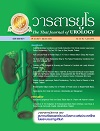Hypocitraturia: Mechanism and Therapeutic Strategies
Abstract
Citric acid is a weak tricarboxylic acid naturally found in citrus fruits. Biochemically, it is a vital intermediate in the Krebs cycle in all living organisms. In urine, citrate plays an important role in preventing stone formation. Hypocitraturia, a low urinary citrate excretion is a well recognized kidney stone risk factor. Hypocitraturia is the most prevalent metabolic abnormality (77-100%) found in kidney stone patients in the northeastern (NE) Thailand, occurred coincidently with hypokaliuria (77-91%) and hypokalemia (10-37%). Studies suggested that the NE stone patients had a state of potassium deficiency due to low dietary intake of potassium and high sweat loss. Acid loading test suggested that the hypokaliuric and hypocitraturic phenotypes did not caused by distal tubular acidosis. We hypothesize that potassium depletion triggers hypocitraturia in NE stone patients. In addition, low consumption of citrus fruit and intake of high-carbohydrate/low-fat diets were found to be a dietary habit of these patients. Potassium depletion causes intracellular acidosis in renal tubular cells. Two pathways of citrate breakdown, 1) entering Krebs cycle to produce CO2 (bicarbonate precursor) and 2) lysing by ATP-citrate lyase in cytoplasm to produce acetyl CoA (fatty acid precursor) and oxaloacetate (glucose precursor), are induced by intracellular proton. Reduced intracellular citrate in turn accelerates the reabsorption of urinary citrate by sodium-dicarboxylate cotransporter-1 (NaDC-1), leading to hypocitrauria. AA genotype of I550V polymorphism in NaDC-1 gene was associated with hypocitraturic phenotype in our kidney stone cohort. These dietary and genetic factors may act in concert to cause a severely low urinary citrate excretion in the NE stone patients. Our recent studies showed that patient with nephrolithiasis had increased oxidative stress, enhanced renal tubular injury and declined renal function. In addition, intrarenal inflammation was commonly observed in kidney biopsies of the NE stone patients. Regimen that is capable of increasing urine pH and citrate, together with reducing oxidative stress and renal tubular damage, is in need to be developed. Our pilot data demonstrated that 3-month treatment with lime powder regimen (LPR, containing 21 mEq of potassium and 63 mEq of citrate) significantly increased urinary pH, potassium and citrate, and also reduced degrees of oxidative stress and renal tubular injury. We hypothesize that our limeade-based regimen could be a novel efficient medication for treating kidney stone disease in Thailand. Nationwide multi-center clinical trials (phases 1, 2 and 3) of LPR in Thai kidney stone patients are currently being planned to conduct by our group.Downloads
Published
2012-12-01
How to Cite
Tosukhowong, P., Boonla, C., & Tungsanga, K. (2012). Hypocitraturia: Mechanism and Therapeutic Strategies. Insight Urology, 33(2), 98–105. retrieved from https://he02.tci-thaijo.org/index.php/TJU/article/view/63156
Issue
Section
Original article



